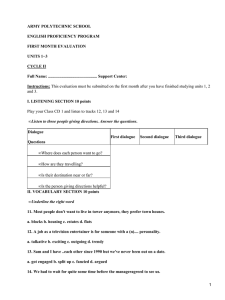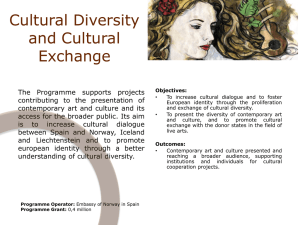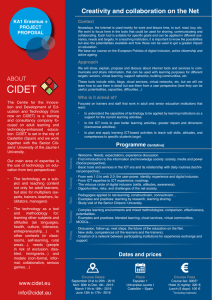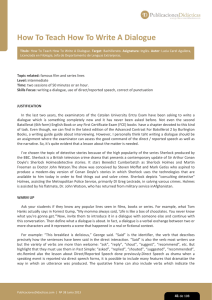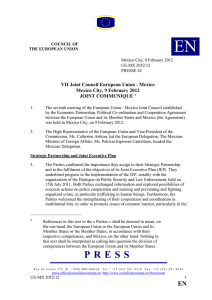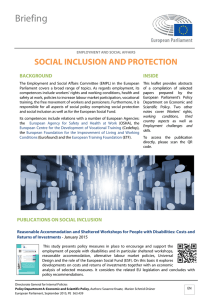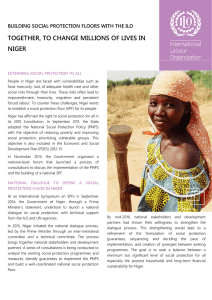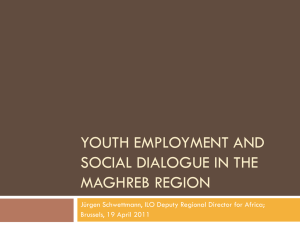TOLERANCE, EMPATHY, OR INCLUSION? INSIGHTS FROM
Anuncio
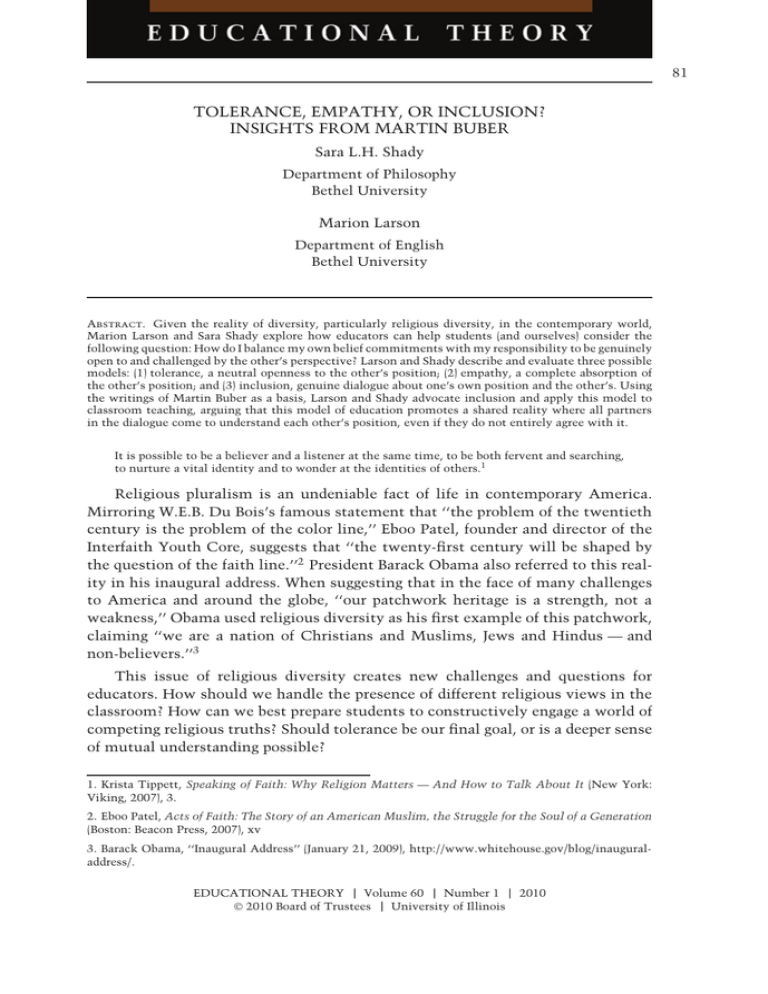
81 TOLERANCE, EMPATHY, OR INCLUSION? INSIGHTS FROM MARTIN BUBER Sara L.H. Shady Department of Philosophy Bethel University Marion Larson Department of English Bethel University Abstract. Given the reality of diversity, particularly religious diversity, in the contemporary world, Marion Larson and Sara Shady explore how educators can help students (and ourselves) consider the following question: How do I balance my own belief commitments with my responsibility to be genuinely open to and challenged by the other’s perspective? Larson and Shady describe and evaluate three possible models: (1) tolerance, a neutral openness to the other’s position; (2) empathy, a complete absorption of the other’s position; and (3) inclusion, genuine dialogue about one’s own position and the other’s. Using the writings of Martin Buber as a basis, Larson and Shady advocate inclusion and apply this model to classroom teaching, arguing that this model of education promotes a shared reality where all partners in the dialogue come to understand each other’s position, even if they do not entirely agree with it. It is possible to be a believer and a listener at the same time, to be both fervent and searching, to nurture a vital identity and to wonder at the identities of others.1 Religious pluralism is an undeniable fact of life in contemporary America. Mirroring W.E.B. Du Bois’s famous statement that ‘‘the problem of the twentieth century is the problem of the color line,’’ Eboo Patel, founder and director of the Interfaith Youth Core, suggests that ‘‘the twenty-first century will be shaped by the question of the faith line.’’2 President Barack Obama also referred to this reality in his inaugural address. When suggesting that in the face of many challenges to America and around the globe, ‘‘our patchwork heritage is a strength, not a weakness,’’ Obama used religious diversity as his first example of this patchwork, claiming ‘‘we are a nation of Christians and Muslims, Jews and Hindus — and non-believers.’’3 This issue of religious diversity creates new challenges and questions for educators. How should we handle the presence of different religious views in the classroom? How can we best prepare students to constructively engage a world of competing religious truths? Should tolerance be our final goal, or is a deeper sense of mutual understanding possible? 1. Krista Tippett, Speaking of Faith: Why Religion Matters — And How to Talk About It (New York: Viking, 2007), 3. 2. Eboo Patel, Acts of Faith: The Story of an American Muslim, the Struggle for the Soul of a Generation (Boston: Beacon Press, 2007), xv 3. Barack Obama, ‘‘Inaugural Address’’ (January 21, 2009), http://www.whitehouse.gov/blog/inauguraladdress/. EDUCATIONAL THEORY Volume 60 Number 1 © 2010 Board of Trustees University of Illinois 2010 82 EDUCATIONAL THEORY Volume 60 Number 1 2010 In recent decades, several scholars have suggested that education should be thought of as an act of hospitality, and this line of research provides helpful ways of thinking about encountering diversity in the classroom. The teacher, as host, seeks to create a space in which students, as guests, can feel supported and safe as they travel the path of development and learning. Parker Palmer, for example, suggests that ‘‘hospitality means receiving each other, our struggles, our newborn ideas with openness and care.’’4 Similarly, Henri Nouwen describes students as ‘‘temporary visitors who have been in many rooms before they came to ours.’’ Such visitors need our ‘‘supportive presence’’ and a ‘‘space with safe boundaries.’’5 And John Bennett says that ‘‘being academically hospitable means letting others know they matter as fellow inquirers.’’6 Much of this literature suggests that educators have a responsibility to find a proper balance between building open relations with students and respecting each student’s personal autonomy by acknowledging their otherness. While we affirm the importance of interpersonal boundaries addressed in this literature, we also believe that educators must consider the issue of proper intellectual boundaries. In particular, we seek to explore how we can help our students (and ourselves) consider the following question: How do I balance my own belief commitments with my responsibility to be genuinely open to and challenged by the other’s perspective? In this essay we maintain that the work of Martin Buber holds fruitful answers to the challenging questions of diversity in the twenty-first century. Religious difference was a central theme in Buber’s life and work, and his writings not only provide helpful insight into the issue of maintaining proper interpersonal boundaries, but they also describe a healthy interpersonal relation as one where truth arises through a process of dialogue by which I come to see the other’s side while at the same time remaining rooted in my own view. In fact, Buber’s belief that the relation between educator and student should be one of inclusion directly links the issue of interpersonal boundaries with intellectual boundaries. According to Buber, ‘‘the relation in education is 4. Parker Palmer, To Know as We Are Known: Education as a Spiritual Journey (San Francisco: Harper and Row, 1983), 73–74. 5. Henri Nouwen, Reaching Out: The Three Movements of the Spiritual Life (Garden City, New York: Doubleday, 1975), 63. 6. John Bennett, Academic Life: Hospitality, Ethics, and Spirituality (Bolton, Massachusetts: Anker, 2003), 48. SARA L.H. SHADY is Associate Professor in the Department of Philosophy at Bethel University, P.O. Box 76, 3900 Bethel Drive, St. Paul, MN 55112; e-mail <[email protected]>. Her primary areas of scholarship are twentieth-century continental philosophy and issues of religious diversity in social and political philosophy. MARION LARSON is Professor in the Department of English at Bethel University, P.O. Box 76, 3900 Bethel Drive, St. Paul, MN 55112; e-mail <[email protected]>. Her primary areas of scholarship are interfaith dialogue, hospitality and education, and faculty development. Shady and Larson Tolerance, Empathy, or Inclusion? one of pure dialogue.’’7 Enabling genuine dialogue about diverse ideas requires a consideration of both the interpersonal dynamics of the relation between teacher and student, as well as the interpersonal dynamics of the pursuit of truth itself. This model of education promotes a shared reality where all partners in the dialogue come to understand each other’s position, even if they do not entirely agree with it. Central Concepts in Buber’s Philosophy of Education Much like the rest of his philosophy, Buber’s theory of education is more suggestive than systematic. In essays and lectures on the topic of education, Buber provided poetic descriptions of the role of the educator, the relation between educator and student, and the goals of education. For example, in Pointing the Way Buber described education as the pursuit of truth: The education I mean is a guiding towards reality and realization. That man alone is qualified to teach who knows how to distinguish between appearance and reality, between seeming realization and genuine realization, who rejects appearance and chooses and grasps reality, no matter what world-view he chooses. This education educates the adherents of all world-views to genuineness and to truth. It educates each of them to take his world-view seriously: to start from the genuineness of its ground and to move toward the truth of its goal. (PW, 105) In addition, he suggested that the goal of education is to produce relations of mutuality: The question is not one of exercising ‘‘tolerance,’’ but of making present the roots of community and its ramifications, of so experiencing and living in the trunk. . . that one also experiences, as truly one’s own, where and how the other boughs branch off and shoot up. It is not a question of a formal apparent understanding on a minimal basis, but of an awareness from the other side of the other’s real relation to the truth. What is called for is not ‘‘neutrality’’ but solidarity, a living answering for one another — and mutuality, living reciprocity; not effacing the boundaries between the groups, circles, and parties, but communal recognition of the common reality and communal testing of the common responsibility. (PW, 102) In other essays Buber extended these goals to include the idea that the educator is a ‘‘vehicle’’ by means of which students encounter ‘‘the world bound up in community, turned to God’’ and who guides students to be ‘‘face to face with God.’’8 Although these images of education are fruitful for considering how and why to educate students in a manner that transcends a mere transmission of factual information, it is difficult to piece together a succinct overview of Buber’s theory of education. In order to better understand Buber’s statements regarding education, it is helpful to understand the key philosophical themes that are woven through all of his work. At the core of Buber’s writings is his famous distinction between I-It and I-Thou. These terms describe two possible ways of being in relation to the world, other human beings, and God. According to Buber, the self is always in relation 7. Martin Buber, Pointing the Way, trans. and ed. Maurice Friedman (New York: Harper and Brothers, 1957), 98. This work will be cited in the text as PW for all subsequent references. 8. Martin Buber, Between Man and Man, trans. Ronald Gregor Smith (Boston: Beacon Press, 1955), 101 and 117. This work will be cited in the text as BMM for all subsequent references. 83 84 EDUCATIONAL THEORY Volume 60 Number 1 2010 to others. It is not a question of whether the self will relate to the other, but rather of how the self will relate to the other. For Buber, the primary relation is that of I-Thou. In this mode of being, the self directly participates in reality with the other by turning to the other as Thou, confirming the other as a partner, and transcending the boundary of the objective distance that separates them. The self neither subsumes the other into him- or herself, nor is the self subsumed by the other; rather, the self and other coexist dialogically in a world of relation characterized by solidarity and genuine fellowship. Buber also recognized, however, that the majority of human experience takes place in the mode of being that he referred to as I-It. Buber refrains from making a normative judgment about the relation of I-It in itself, suggesting rather that the relation of I-It is necessary but insufficient. As Buber famously stated, ‘‘without It man cannot live. But he who lives with It alone is not a man.’’9 In the I-It mode of being, the self considers the other as an object of his or her activities and thoughts, solidifying the primordial distance that separates the self from the other as two distinct entities. This is the world of experience, where the self apprehends the other objectively, seeks to place the other in continuity with the totality of his or her experience, and analyzes the other in terms of rules and laws. According to Buber, the limitation of I-It is that in this mode of relation the self fails to recognize the true presence of the other. It is essential to realize, however, that the possibility for moving from I-It to I-Thou is not solely dependent upon the attitude with which the self approaches the other. The I-Thou mode of being involves mutuality between the self and other, so the relation only arises when the self turns to the other as Thou and the Thou responds. For this reason, Buber often described the I-Thou mode of being as a ‘‘meeting’’ between self and other: ‘‘The Thou meets me through grace — it is not found by seeking. But my speaking of the primary word to it is an act of my being. . . . The Thou meets me. But I step into direct relation with it. Hence the relation means being chosen and choosing’’ (IT, 76). This also implies that the self is affected by the relation just as much as the other is. As Buber explained, ‘‘the primary word I-Thou can be spoken only with the whole being. Concentration and fusion into the whole being can never take place through my agency, nor can it ever take place without me. I become through my relation to the Thou as I become I, I say Thou. All real living is meeting’’ (IT, 11). Buber identified the ‘‘Between’’ as the ontological category where ‘‘meeting’’ occurs. For Buber, the Between is ‘‘the narrow ridge between subjective and objective where I and Thou meet’’ (BMM, 204). It is ‘‘a sphere which is common to them but which reaches out beyond the special sphere of each’’ (BMM, 203). He maintained that this sphere is present when something happens that cannot be completely attributed to the objectivity of the world, or to the subjectivity of the self, but transcends both. The meeting of I and Thou in the sphere of the 9. Martin Buber, I and Thou, trans. Ronald Gregor Smith (New York: Charles Scribner’s Sons, 1958), 34. This work will be cited in the text as IT for all subsequent references. Shady and Larson Tolerance, Empathy, or Inclusion? Between has important relevance for both understanding and applying Buber’s theory of education. For Buber, education is not merely the transmission of factual knowledge from teacher to pupil. Rather, education is something that happens between teacher and student, affecting both of them. Education as Inclusion Buber often used the metaphor of dialogue to describe what takes place between I and Thou, and this is an essential concept for understanding Buber’s theory of education. It is important to recognize that, for Buber, dialogue does not have to involve actual speech. In Buber’s words, ‘‘just as the most eager speaking at one another does not make a conversation. . .so for a conversation no sound is necessary, not even a gesture’’ (BMM, 3). Rather, dialogue is something that happens, that is present, when there is ‘‘a genuine change from communication to communion’’ or ‘‘an embodiment of the word of dialogue’’ (BMM, 5). Buber distinguished three primary types of dialogue (BMM, 19). Technical dialogue occurs when individuals converse for the purpose of building objective understanding. While important, this form of dialogue is limited, because neither partner recognizes the possibility for disclosing anything meaningful beyond objective knowledge itself. A second form of dialogue — monologue — occurs when each partner in the conversation is more concerned with having his or her own beliefs confirmed than with the partner who is capable of expanding his or her horizons. Buber referred to the third type of dialogue as ‘‘genuine dialogue’’ and claims that this occurs ‘‘where each of the participants really has in mind the other or others in their present and particular being and turns to them with the intention of establishing a living mutual relation between himself and them’’ (BMM, 19). Buber maintained that there are different degrees of genuine dialogue, depending on the degree of inclusion and mutuality present between persons (BMM, 98–101). He defined inclusion as: The extension of one’s own concreteness, the fulfillment of the actual situation of life, the complete presence of the reality in which one participates. Its elements are first, a relation of no matter what kind, between two persons, second an event experienced by them in common, in which at least one of them actually participates, and third, the fact that this one person, without forfeiting anything of the felt reality of his activity, at the same time lives through the common event from the standpoint of the other. (BMM, 97) Inclusion arises in a ‘‘meeting’’ between persons, and it is important to remember that we cannot force its presence. While inclusion can be present through only one individual’s active participation, dialogue requires at least partial involvement of both persons. Genuine dialogue requires inclusion, but each person can only be responsible for his or her own openness to inclusion. Using Buber’s language, I must ‘‘turn’’ toward the standpoint of the other, and if the other ‘‘turns’’ toward my standpoint, genuine dialogue can arise. As Buber noted, ‘‘a relation between two persons that is characterized in more or less degree by the element of inclusion may be termed a dialogical relation’’ (BMM, 97). When two individuals are recognized and affirmed with at least some degree of mutuality, genuine dialogue is present. 85 86 EDUCATIONAL THEORY Volume 60 Number 1 2010 So, any form of genuine dialogue must involve an attitude of openness by both partners to include the other in the sphere of commonality between them. The degree of inclusion, however, varies. For example, a disagreement where both participants recognize the legitimacy of the other’s standpoint as sharing in the truth, but at the same time do not relativize the truth, is a form of genuine dialogue. It is limited, however, because it is not completely inclusive. While each person abstractly recognizes the other existentially, as a person, they do not seek to experience the life of the other from the other’s perspective. In contrast to a relation with little inclusion, Buber suggested that a friendship provides the most ‘‘concrete and mutual’’ experience of inclusion (BMM, 99). In friendship, two persons reciprocally recognize and include each other as whole persons, give themselves freely to the discussion, and do not seek to impose their ideas upon the other. According to Buber, the relation between teacher and student should involve a degree of inclusion that is somewhere between the previous two examples. Genuine education requires genuine dialogue, although the possibility for inclusion between teacher and student is somewhat limited. When an instructor considers both his or her own position as educator and the position of a student as a person being educated, inclusion is present. The relation is not completely inclusive, however, because it is not completely reciprocal. While the educator can be aware of both his or her own situation and that of the student, the student is unable to consider fully the perspective of the educator.10 The work of the educator therefore involves bringing the student into the relation of genuine dialogue by seeking to understand the student. Similarly, the educator can foster genuine dialogue among students and between students and texts, so that the students experience others in an inclusive manner. Genuine dialogue in an educational setting may extend beyond the boundaries of actual conversation. According the Buber, ‘‘Not only is the shared silence of two such persons [in a dialogical relation] a dialogue, but also their dialogical life continues, even when they are separated in space, as the continual potential presence of the one to the other, as an unexpressed intercourse’’ (BMM, 97). Increasing the degree of genuine dialogue present in education will build a living relation of inclusion between participants. In advocating openness toward students and toward the ideas we explore in our classrooms, we refrain from completely advocating two common educational goals, tolerance and empathy, because we see tolerance as inadequate and empathy as potentially problematic. To many in a pluralistic society, tolerance sounds like a desirable goal — a means of coexistence amid sometimes violent disagreement. In tolerating another person or viewpoint, we begin by working to cultivate ‘‘generic openness’’ (PW, 102).11 We seek to remain neutral so that we can put up with ideas and people that we might find distasteful. There certainly are situations in today’s 10. It is worth noting that in the essay in which Buber described the limitations of inclusion in the relation between teacher and student, his focus is primarily on the education of children. A greater degree of inclusion may be possible in relations between college students and professors. 11. See also Bennett, Academic Life, 47. Shady and Larson Tolerance, Empathy, or Inclusion? world where difference has erupted in acts of violence. In such contexts, learning to tolerate others represents progress and can become an initial step toward mutual understanding and perhaps even reconciliation. But tolerance cannot be seen as a goal because it does not go far enough — like I-It relationships, it is necessary but insufficient. Discussions that emphasize tolerance can become little more than monologue that is disguised as dialogue. Because open conflict is avoided, it appears that people are listening to each other, that they are approaching new texts and ideas openly (BMM, 18–19). Really, though, many participants are merely speaking to themselves. Such a mindset does not help get at the root of violence and disagreement, and it does not encourage us to see how and if our own perspectives toward others might be problematic. (In fact, such a mindset may even strengthen negative thoughts and feelings toward others!) It does not acknowledge the many ways in which human selves are interconnected and the ways in which coming to know is a collaborative venture. Instead, tolerance fosters I-It relations that distance and objectify. So tolerance is inadequate, in part, because it maintains too much distance between people and their ideas, ultimately treating them like objects to be examined. Empathy — marked by a person’s efforts to get outside him- or herself and enter another’s perspective — initially sounds like a better goal. Of course we all should work to see the world from other vantage points. Such acts of seeing help promote emotional connections between people as well, and these connections are crucial in overcoming exclusion and making peace. Buber agreed that this is desirable, but he argued that empathy goes too far when it fails to maintain the necessary distance between people. While learning to see ‘‘from the standpoint of the other’’ is crucial, according to Buber, this needs to happen in such a way that each person does not lose sight of his or her own standpoint (BMM, 97). When this occurs, empathy can amount to ‘‘amorphous enmeshment,’’ a collectivity in which personal existence is atrophied.12 This makes empathy ‘‘an act of self-annulment and self-omission.’’13 So while it is crucial to learn to see and feel from another perspective, it is equally important to approach difference in a way that does not result in dissolving difference by losing one’s own voice in the dialogue. To do so gets in the way of developing deeper and potentially life-changing relations (BMM, 97). According to Buber, our identities are dialogical in nature; each person’s existence is really a coexistence. Actualizing wholeness as a self is not something a person can do alone, nor is it something that can be done for a person. As noted earlier, Buber maintained that ‘‘I become through my relation to the Thou; as I become I, I say Thou. All real living is meeting’’ (IT, 11). Genuine dialogue is only present in a meeting between persons that neither mere tolerance nor empathy allows. 12. Steven Kepnes, The Text as Thou: Martin Buber’s Dialogical Hermeneutics and Narrative Theology (Bloomington: Indiana University Press, 1992), 131. This idea is drawn from Buber’s discussion in Between Man and Man, 31. 13. Adir Cohen, ‘‘Martin Buber and Changes in Modern Education,’’ Oxford Review of Education 5, no. 1 (1979): 81–103. 87 88 EDUCATIONAL THEORY Volume 60 Number 1 2010 If neither tolerance nor empathy is our ultimate goal, then what should we seek to foster? Buber’s concept of inclusion provides a viable alternative. Unlike tolerance, inclusion seeks to break down boundaries and develop deep relations with other people and with things that others have created, such as texts and works of art.14 For such a relation to develop, one must be a ‘‘receptive beholder,’’ approaching others with an attitude of ‘‘mutuality, openness, [and] listening. . . [a] ‘sense of wonder’ and ‘astonishment’.’’15 Adir Cohen describes this as a relation of realization, a willingness to be subject to the person or text one encounters, engaging in dialogue by listening as well as replying to the questions posed by others.16 For this to occur, one must be willing to let the other change one’s perspective rather than seeking to impose one’s own views.17 The goal of genuine dialogue is to build mutual understanding, and this cannot be reduced to mutual tolerance for at least two reasons. Buber maintained that any genuine meeting between I and Thou affects both partners in the dialogue. The I is conscious of him- or herself as a whole person in relation with other whole persons. The I is both free to be him- or herself and aware of his or her responsibility to the other. Reciprocally, the other is also recognized as a person to whom the self must give a response. The genuine dialogue opens up both freedom and responsibility for the other as well. Such an attitude of absolute receptiveness may sound like the boundaryerasing stance of the empathy that Buber rejected. It does not have to be, though. While one seeks to cultivate openness and receptiveness, at the same time, there is a recognition of the distance between beings, of ‘‘boundaries delineating. . .different beings.’’18 While inclusiveness involves ‘‘complete presence in a shared reality,’’19 a ‘‘coming to know one another in strengths and weaknesses,’’ it does not also involve ‘‘losing the self.’’20 In ‘‘Education and World-View,’’ Buber described what an educational community marked by inclusion might look like: The work of education unites the participating groups. . .into a model of the great community. This community is no union of the like-minded but a genuine living together of men of similar or of complementary natures, but of differing minds. Community is the overcoming of otherness in living unity. (PW, 102) Caroline Westerhoff, exploring the positive role of boundaries in human relations, provides an additional glimpse of the balancing that characterizes inclusion: 14. See, for example, Steven Kepnes, ‘‘Buber as Hermeneut: Relations to Dilthey and Gadamer,’’ Harvard Theological Review 81, no. 2 (1988): 211; and Bennett, Academic Life, xi. 15. Kepnes, The Text as Thou, 24, 59, and 72. See also Haim Gordon and Rina Shtelman, ‘‘A Buberian Educational Approach to Cubist Art,’’ Journal of Aesthetic Education 34, no. 1 (2000): 98. 16. Cohen, ‘‘Martin Buber and Changes in Modern Education,’’ 52 and 65. 17. Haim and Shtelman, ‘‘A Buberian Educational Approach to Cubist Art,’’ 101. 18. Kepnes, The Text as Thou, 131. 19. Cohen, ‘‘Martin Buber and Changes in Modern Education,’’ 91. 20. Sean Blenkinsop, ‘‘Martin Buber: Educating for Relationship,’’ Ethics, Place, and Environment 8, no. 3 (2005): 295. Shady and Larson Tolerance, Empathy, or Inclusion? Boundaries separate and define us so that we can be together. If we do not assert who we are and what we are about — if we try to be everything to everybody — we finally will have nothing to offer anyone. And if we do not make the effort to learn who others are and what they are about, we will not be able to connect with them and receive all that they hold out to us.21 Inclusion seeks to hold some features of both tolerance and empathy in tension. For this reason, it is fair to say that ‘‘the educational situation requires the striking of a delicate balance between dedication and detachment, between intimacy and distance.’’22 Inclusion involves getting each person to ‘‘take his world-view seriously’’ (PW, 105), and this can only occur through encounters that acknowledge the particularity of each person and context — seeking to explore together the various implications of individual perspectives and of various traditions.23 Such encounters are fostered in classrooms where students’ interests and abilities are acknowledged, serving as a starting point for further exploration.24 Students must feel that they are taken seriously if trust is to develop, thereby making risk-taking and deep learning possible.25 Trust is fostered best in environments marked by ‘‘being rather than seeming.’’ Each participant must work to overcome mere appearances — such as ‘‘one’s effect as speaker’’ on the other person.26 When a person ‘‘seems, he or she is concerned with a certain image and works to create that image to further personal goals,’’ thereby making true dialogue impossible.27 Of course we would all say that we want to avoid such atmospheres in our classrooms. We sometimes do not realize, though, the ways in which our classroom practices might foster seeming rather than being. Pressure to perform mitigates against relations of being. When students fear failure, see themselves as competing against one another, and lack the support necessary for additional growth, they often hesitate to admit questions or confusion. As a result, they focus on how they appear to others. Faculty can also create environments of seeming if they set themselves up as expert dispensers of knowledge, communicating ‘‘critically rather than constructively’’ to students.28 While college classes exist largely to help students develop intellectually and gain information they previously lacked, an exclusive focus on such outcomes is 21. Caroline A. Westerhoff, Good Fences: The Boundaries of Hospitality (Harrisburg, Pennsylvania: Morehouse, 1999), 53. 22. Cohen, ‘‘Martin Buber and Changes in Modern Education,’’ 90. 23. See, for example, Bennett, Academic Life, 47; and Kepnes, The Text as Thou, 149. 24. For further discussion on this topic, see Bennett, Academic Life, 120. 25. The issue of trust is further explored by Buber in Between Man and Man, 106–107. See also Charles V. Willie, ‘‘Confidence, Trust, and Respect: The Preeminent Goals of Educational Reform,’’ Journal of Negro Education 69, no. 4 (2000): 259; and John Thompson, ‘‘‘The Between’ of Teaching Sociology: Ways of Knowing and Teaching,’’ Teaching Sociology 24, no. 3 (1996): 322. 26. Maurice Friedman, Martin Buber: The Life of Dialogue (Chicago: University of Chicago Press, 1955), 87. 27. Leigh Anne Howard, ‘‘From Ivory Tower to Town Hall: Using Dialogic Inquiry as a Critical Pedagogy,’’ American Behavioral Scientist 45, no. 7 (2002): 1131. See also Friedman, Martin Buber, 87. 28. Howard, ‘‘From Ivory Tower to Town Hall,’’ 1131. 89 90 EDUCATIONAL THEORY Volume 60 Number 1 2010 counterproductive for several reasons. As discussed previously, such an emphasis can easily lead students and faculty to focus on their efforts to appear knowledgeable rather than focusing on dialogue, on I-Thou relations, on whole-person development. Learning is not just a matter of acquiring subject matter.29 Such a focus is likely to promote I-It relations between students as well as between students and the ideas they encounter. This is because all of human existence is ‘‘personal’’ in some way. At the same time, the ‘‘world of It’’ is necessary for humans to ‘‘live in ordered society.’’30 We need facts and information, a careful examination of the world around us — but if we stop there or let our students stop there, then we limit ourselves significantly. Instead, learning is both cognitive and affective, involving the whole person.31 ‘‘Education worthy of its name is essentially education of character,’’ Buber asserted (BMM, 112). Among other things, this means that even if a student acquires impressive amounts of information, true education — the education that promotes I-Thou relations and is marked by inclusion — has not necessarily occurred unless these ‘‘disparate items of knowledge. . . become part of an organic spiritual unity.’’32 For this to occur, the teacher must be fully present to students as individuals, never forgetting that each student is a person, not merely an abstract entity,33 developing relations with them that help teacher and student to ‘‘uncover the relationships between oneself, the other, and the world, and find meaning through an understanding of these relationships.’’34 In approaching his or her students as whole people, the teacher considers both each student as he or she is now as well as considering each student’s possibilities (BMM, 104). Buber put it this way: ‘‘I have been put here and have to accept them as they are — but not as they now are in this moment, no, as they really are, as they can become’’ (BMM, 112). Buber noted that such teaching requires several things. Teachers must be humble, recognizing that many factors are at work in the development of their students: the teacher is ‘‘only one element amidst the fullness of [a student’s] life’’ (BMM, 106). Teachers must be self-aware, not forgetting their desire to have a whole-person impact on their students. Because of such a goal — and recognizing the potential vulnerability of learners in their care — teachers must be willing to take responsibility for the influence that they exert on their students (BMM, 106). Rather than seeking to impose their views on students, teachers seek to get each person in class to ‘‘take [their] world-view seriously.’’ 29. Cohen, ‘‘Martin Buber and Changes in Modern Education,’’ 98. 30. Ronald Gregor Smith, Martin Buber (Richmond, Virginia: John Knox, 1967), 18. 31. This idea is emphasized in both Thompson, ‘‘‘The Between’,’’ 323; and Buber, Between Man and Man, 104. 32. Cohen, ‘‘Martin Buber and Changes in Modern Education,’’ 98. 33. Ibid., 93. 34. Aidan Curzon-Hobson, ‘‘Higher Education in a World of Radical Unknowability: An Extension of the Challenge of Ronald Barnett,’’ Teaching in Higher Education 7, no. 2 (2002): 185. Shady and Larson Tolerance, Empathy, or Inclusion? Buber maintained that educators must resist imposing truth on their students. As Buber described, educators should seek ‘‘a lofty asceticism: an asceticism which rejoices in the world, for the sake of the responsibility for a realm of life which is entrusted to us for our influence but not our interference’’ (BMM, 95). Educators interfere with the process of genuine learning when they exhibit a ‘‘will to power’’ through which they attempt to convince students of the truth by convincing them that they are an authority on the truth. Genuine education cannot take place through coercion. Alternatively, educators can interfere with the learning process if they are motivated by Eros, which can take the shape of selecting certain students to teach for their own pleasure by attempting to set the students ‘‘free’’ from compulsory education. This model of education, however, neglects the important goal of fostering genuine community. Buber asserted that ‘‘at the opposite pole from compulsion there stands not freedom but communion. . . freedom in education is the possibility of communion’’ (BMM, 91). Both of these models of education ultimately stifle the growth of the student. The true concern of educators should be to open the student to the wholeness of his or her own being and relation to others, for the student’s own good and for the sake of community. There is an apparent tension here in Buber’s argument. On the one hand, educators are responsible for creating an open space for students to freely learn and encounter truth. We should avoid dictating what the end result of a particular pursuit of knowledge will look like, as knowledge will only be attained in full through open dialogue. On the other hand, educators are supposed to educate. In Buber’s words, the teacher has to ‘‘introduce discipline and order. . .establish a law, and he can only strive and hope for the result that discipline and order will become more and more inward and autonomous’’ (BMM, 113). This seemingly would require an educator to relate to students in the I-It mode of being. Perhaps this tension can be resolved with a return to Buber’s famous statement ‘‘without It man cannot live. But he who lives with It alone is not a man’’ (IT, 34). Educators cannot teach without a commitment to truth, but in many cases the transmission of objective facts to students should not be their only goal. Imagine a situation where a student in your classroom openly makes an offensive and ill-informed comment about race. From this student’s perspective, students of color should not be admitted into your institution because he believes they will bring down the overall quality of education for everyone. Clearly this presents a situation where the educator has a responsibility to ‘‘establish a law.’’ This could be done by showing the student the fallacies present in his argument, introducing factual evidence that contradicts his thesis, and clearly delineating the boundaries of appropriate and inappropriate speech in the classroom. But, the educator who seeks to promote genuine inclusion in the classroom should also recognize the possibility to transcend the I-It mode in this moment. By opening a space where all students in the classroom can discuss the issue from different perspectives and seek to understand both why the student making the comment sees the world in this way as well as why others see his position as harmful, the instructor allows for a possible ‘‘meeting’’ between persons in the classroom. It is in this dimension 91 92 EDUCATIONAL THEORY Volume 60 Number 1 2010 of teaching that genuine intellectual and personal growth can occur. For Buber, ‘‘the truth of a world-view is not proved in the clouds but in lived life’’ (PW, 103). Models of Inclusion Cultivating inclusion in the classroom may sound like a desirable goal, but is it really possible to enter into another’s perspective without losing sight of one’s own? Krista Tippett, creator and host of public radio’s Speaking of Faith and author of the recent spiritual memoir by the same title, asserts that ‘‘it is possible to be a believer and a listener at the same time, to be both fervent and searching, to nurture a vital identity and to wonder at the identities of others.’’35 In her weekly interviews with people of various faiths and in her book, Tippett provides numerous pictures of such believing listening, such fervent searching, which can help us envision more clearly what Buber’s inclusion might look like. In Tippett’s book, British historian and theologian Karen Armstrong describes a time when reading a footnote changed her perspective on her own academic task. The footnote said that the religious historian, rather than simply seeking to amass facts in order to learn about another time and place, ought to seek to ‘‘enter the minds’’ of those being studied. Armstrong describes the purpose of such an endeavor this way: ‘‘And filling up with scholarly knowledge the background until you come to the point where you can imagine yourself feeling the same, or believing the same as them, until basically the intellectual idea learns to reverberate with you personally.’’36 Armstrong’s description exemplifies Buber’s notion of education. She shows that education is not merely cognitive but is also necessarily affective and even spiritual. She shows that inclusion is marked by a willingness to open oneself to new ideas and perspectives — perhaps even being changed by them — but doing so without losing sight of oneself. In her description of an interview with Elie Wiesel, Tippett provides a touching illustration of what it can look like when persons seek to be open to the thoughts and feelings of another while, at the same time, retaining their own histories and perspectives. Wiesel is a Jewish Holocaust survivor whose speaking and writing makes vivid the utter horror of such experiences and their aftermath, as he works to ensure that the actions of those who perpetrated such evil will never be forgotten — in hopes that such acts may never again be repeated. Several years ago, Tippett interviewed Wiesel when he was visiting Berlin for the first time since the Holocaust. During that trip, Wiesel asked to meet with a group of young Germans and was ‘‘visibly shaken’’ by the conversation. ‘‘I had never before considered,’’ Wiesel said to Tippett, ‘‘that it could be as painful to be a child of those who ran the camps as a child of those who died in them.’’37 Another picture of inclusion comes from a recent interview that Tippett conducted with Eboo Patel, a practicing Muslim and founder of the Interfaith 35. Tippett, Speaking of Faith, 3. 36. Ibid., 50. 37. Ibid., 39. Shady and Larson Tolerance, Empathy, or Inclusion? Youth Core. Participants in the Youth Core are teenagers and young adults of faith, from traditions such as Christianity, Judaism, and Islam. According to the Interfaith Youth Core Web site, their goals for interfaith dialogue are threefold: 1. To help participants discover the shared value of service across different religious traditions through scripture, storytelling, and action. 2. To encourage participants to grow in their own faith identities, learning how to talk about what they believe, even as they [are] learning to listen to others. 3. To build a sense of cooperation and collaboration amongst religiously diverse young people on campus and in the community.38 Working together on service projects and talking with each other about ways in which their faith traditions might inform a life of service and interfaith cooperation, participants are able to grow in their own faith while at the same time learning to appreciate the beliefs and traditions of others. A consideration of the tension between believing and listening within the context of the classroom suggests some specific things teachers can do to foster and sustain an environment of inclusion. Buber spoke often of the trust that must develop between student and teacher as well as between and among learners in the classroom if inclusion is to be fostered. Trust is crucial, says Lois Callan Trautvetter, because ‘‘everyone, including faculty and students, needs to have the psychological safety to explore, question, confide, and share with others. Thus, it is essential to keep in mind that student exploration and self-critical reflection will occur only if the class environment is considered safe.’’39 It takes courage to ‘‘step out of the safety’’ of one’s existing perspectives40 — even if one is only doing so temporarily in order to understand new ideas. Because of this, faculty must pay careful attention to the ways in which language can function to promote or to inhibit student exploration of new and personally challenging ideas. First, provide students with low-risk opportunities to process their thoughts and feelings orally and in writing. Students need to know that they can express their fears, try to articulate a new perspective, ask questions, and seek to support ideas that are important to them without a classmate or teacher attacking them. Small group discussions, anonymous postings to a class electronic discussion forum, and guided journal assignments can provide students with opportunities for low-risk expression as well as giving them a chance to receive feedback from classmates and their instructor. Giving students comments (but no grade) on drafts or on short, informal writing assignments can also lower the risk associated with writing about material with which they might struggle — cognitively, emotionally, or both. 38. Interfaith Youth Core, ‘‘Facilitator’s Guidelines — Dialogue on the Shared Value of Service,’’ http:// www.ifyc.org/system/files/Facilitators+Guidelines.pdf. 39. Lois Callan Trautvetter, ‘‘Undergraduate Perspectives About Religion in Higher Education,’’ in Encountering Faith in the Classroom, ed. Miriam Rosalyn Diamond (Sterling, Virginia: Stylus, 2008), 40. See also Nouwen, Reaching Out, 60–61. 40. Peggy Catron, ‘‘Blinking in the Sunlight: Exploring the Fundamentalist Perspective,’’ in Encountering Faith in the Classroom, ed. Diamond, 72. 93 94 EDUCATIONAL THEORY Volume 60 Number 1 2010 Second, seek to cultivate a culture of dialogue and conversation in the class rather than that of argument or debate.41 While debates can be engaging, pushing students to argue for a position can be counterproductive. Mano Singham points out that a debate approach encourages participants to spend time ‘‘hiding the weaknesses and exaggerating the strengths of their own position, while at the same time ignoring or minimizing the strengths of other views and emphasizing their flaws.’’42 To avoid this, Robert Nash identifies three attitudes in particular that participants need to bring to the conversation and work to develop through their dialogues. Participants should first seek to ‘‘open conversational spaces’’ through practicing what Nash refers to as the ‘‘golden rule of moral conversation: listen to others as we would be listened to. We need to question and challenge others as we would be questioned and challenged.’’43 In addition, each participant needs to be willing to recognize that he or she is not the only one in the room with ‘‘wisdom and insight into truth’’ and that contributions from others are ‘‘worthwhile in some way.’’ For this reason, each idea needs to be given at least an initial ‘‘right to be heard and understood,’’ and each participant works to listen in order to understand rather than to correct or argue.44 Finally, particularly when encountering difficult or controversial topics, participants work together to look for what they might have in common. This might involve trying to ‘‘embrace. . . even the smallest kernel of truth’’ in perspectives with which one disagrees; if that is not possible, then at least ‘‘make a commitment to try to understand (not agree with)’’ what is so important about the perspective ‘‘of the other for the other.’’45 In other words, write Robert Nash and Sue Baskette, we need to learn to practice the Latin root of ‘‘respect,’’ which means ‘‘to look back, again and again, to find value in what one might have initially opposed or dismissed.’’46 Third, select language that is most conducive to the cognitive work you want students to tackle, whether it is helping them learn to find flaws in an idea (practice doubting it) or helping them consider the possible strengths in an idea (practice believing it).47 Peter Elbow, who developed what he calls ‘‘the doubting game and the believing game,’’ suggests that we need to help students ‘‘scrutinize with the tool of doubt,’’ seeking to be ‘‘as skeptical and analytic as possible’’ (play 41. Robert J. Nash, DeMethra LaSha Bradley, and Arthur W. Chickering, How to Talk About Hot Topics on Campus (San Francisco: Jossey-Bass, 2008), 4. 42. Mano Singham, ‘‘When Faith and Science Collide,’’ in Encountering Faith in the Classroom, ed. Diamond, 153. 43. Nash, Bradley, and Chickering, How to Talk About Hot Topics on Campus, 20. 44. Ibid., 21–22. 45. Robert J. Nash and Sue M. Baskette, ‘‘Teaching About Religion and Spiritual Pluralism in a Professional Education Course,’’ in Encountering Faith in the Classroom, ed. Diamond, 195. 46. Ibid., 196. 47. Peter Elbow, ‘‘The Believing Game and How to Make Conflicting Opinions More Fruitful,’’ in Nurturing the Peacemakers in Our Students: A Guide to Writing and Speaking Out About Issues of War and of Peace, ed. Chris Weber (Portsmouth, New Hampshire: Heinemann, 2006), http://works. bepress.com/peter elbow/10. This work will be cited in the text as BG for all subsequent references. Shady and Larson Tolerance, Empathy, or Inclusion? the ‘‘doubting game’’), and try to ‘‘find hidden virtues’’ in ideas we disagree with, trying ‘‘to be as welcoming as possible’’ (play the ‘‘believing game’’) (BG, 15–16). In trying to doubt an idea — particularly an idea with which we agree — we work at ‘‘extricating or distancing ourselves.’’ Trying to express this idea in ‘‘clear, impersonal sentences that lay bare the logic or lack of logic’’ helps assist the ‘‘disciplined practice. . .of doubt’’ (BG, 19). To assist the ‘‘disciplined practice. . . of belief’’ — particularly in regard to a perspective with which we disagree — we ought to use ‘‘the language of imagination, narrative, and. . . personal experience’’ (BG, 19). Elbow continues describing the role that language might play in helping learners try out alternate perspectives: When it’s hard to enter into a new point of view, try telling a story of someone who believes it; imagine and describe someone who sees things this way; tell the story of events that might have led people to have this view of the world; what would it be like to be someone who sees things this way? Write a story or poem about the world that this view implies. (BG, 20) Conclusion Using Buber’s idea of inclusion as a way to balance personal beliefs with a commitment to be genuinely open to the other creates a space for reciprocal dialogue that moves beyond the limitations of merely tolerating difference or completely losing ourselves in the other’s position. Karen Armstrong’s reading as an historian of religion, Elie Wiesel’s willingness to consider the perspectives of children of former Nazis, and Eboo Patel’s interfaith work all provide helpful examples of Buber’s concept of inclusion. Similarly, attention to the role played by language in the classroom can encourage openness to new perspectives without pushing participants to become someone they are not. In our interactions with other humans, each must be sure not to attempt to ‘‘impose his own truth or view on the other.’’48 At the same time, participants must bring themselves to each interaction, which includes, at times, saying ‘‘what one really thinks about the matter in question.’’49 In I-Thou relations, ‘‘each of the members of the relation really remains himself, and that means really different from the other. Though the Thou is not an It, it is also not ‘another I.’ He who treats a person as ‘another I’ does not really see that person but only a projected image of himself.’’50 Miroslav Volf aptly describes the twofold nature of true dialogue — in which one continues to be oneself while at the same time seeking to embrace and fully understand the other. Particularly when encountering deep disagreement and lack of mutual understanding, he says that we need to develop the ability to see both ‘‘from here’’ and ‘‘from there.’’ In viewing ‘‘from there’’ and entering another’s perspective, We open our ears to hear how others perceive themselves as well as how they perceive us. We use imagination to see why their perspective about themselves, about us, and about our 48. Friedman, Martin Buber, 86. 49. Ibid., 87. 50. Ibid., 61. 95 96 EDUCATIONAL THEORY Volume 60 Number 1 2010 common history, can be so plausible to them whereas it is implausible, profoundly strange, or even offensive to us.51 Having done this, we then ‘‘take the other into our own world,’’ working to ‘‘compare and contrast the view ‘from here’ and the view ‘from there.’’ At times we will reject one view and embrace the other, or perhaps ‘‘find some compromise between the two.’’ Regardless of the outcome, though, what ‘‘we must do as we take others into our world is let their perspective stand next to ours and reflect on whether one or the other is right, or whether both are partly right and partly wrong.’’52 Buber’s concept of inclusion helps us do exactly that. As we consider how to approach interpersonal and intellectual boundaries in education, it is essential to remember that, as Buber put it, ‘‘what one believes is important, but still more important is how one believes it’’ (PW, 104). 51. Miroslav Volf, Exclusion and Embrace: A Theological Exploration of Identity, Otherness, and Reconciliation (Nashville, Tennessee: Abingdon, 1996), 252. 52. Ibid.
